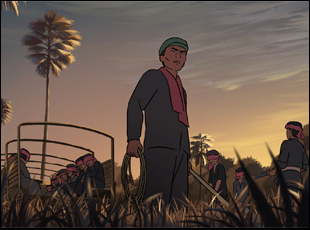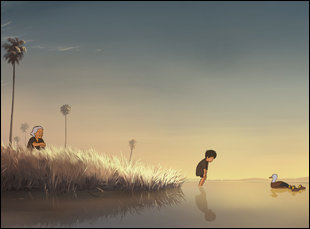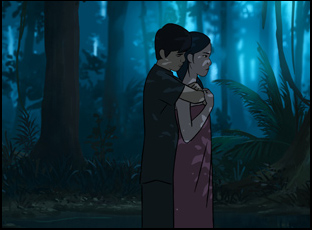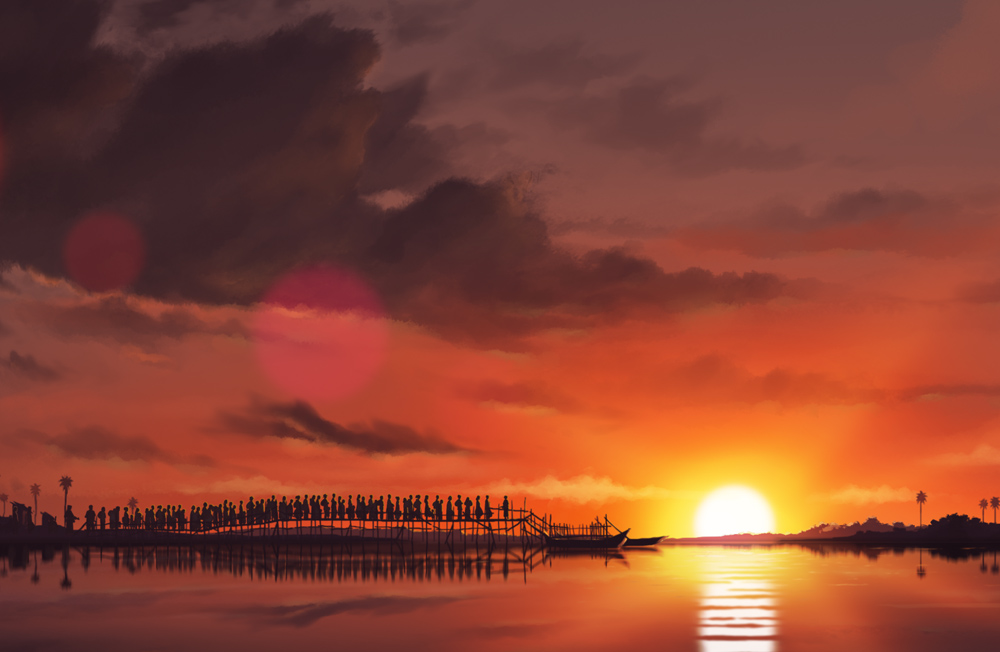
I think “idea” is not a good word. It’s more about testimony, souvenirs and memories and everything is so huge I needed to share it. Everything started when I was three or four years old during a meal. I didn’t finish the dishes — I left many grain of rice [on my plate] and my mother had to find a way to convince me to finish. The first she said was “The rice grain you left in your bowl is the number of dots your future wife will have on her face.” And the other [was] that, “You have to pay respect to all the victims of the Khmer Rouge period because we had nothing to eat at that moment. You should consider each grain of rice like a piece of diamond.” She didn’t mention Khmer Rouge [by name]. She said “The black suit men.” So to me, a young child born in Paris, I saw [these perpetrators as] silhouettes — evil people, very scary.
Then we went to Cambodia in 1995 and I was not really able to link to Cambodia or foreign countries at that moment. My brother almost forced me to go there, and at that moment, I was shocked and scared because I was face to face with the reality of this country’s scars of the civil war. [There was] so much poverty – you are not prepared to see such stuff when you are born in western countries. And I refused to assume those roots and that my parents were born in such a country. But we went back to Cambodia again in 1997, this time with my mother and my little brother and the experience was a bit more interesting because I was able to meet some survivors from my family — my Auntie and my cousin — so it was different.
I put it beside me — all the family stories and all the testimonies — and I started to look for the historical part. I researched everything by myself [to get] the real picture of the Khmer Rouge. Maybe a bit because I was too much naive before, I came to realize Pol Pot and the Khmer Rouge were human like us, so all the imagination – the black suit men – all falls down and I was faced with the reality. Everything was so huge that I decided I should tell that story with a novel or a comic book. A comic book was to me maybe the best way because I love to draw, but life brings me to animation. During my last year at Gobelins School of Visual Arts, [a French animation school], I had a cigarette with a friend and I was sharing my mother’s experience with him, talking about land mines and stuff like that, and he said, in a very friendly way, you should make a film. Everything started at this moment around March or April 2009.

For such a story, it would be maybe more natural to make a documentary, but I like fiction because you can dive through the character’s path. I didn’t want to have distance between characters and what they lived and I didn’t want distance between the audience and the film. I wanted the audience to feel what the characters felt at every moment and the choice of animation is quite interesting for me because you can recreate everything. As I didn’t live during the Khmer Rouge regime, I didn’t pass through what my mother passed through, so there is maybe a kind of guilt from that — to survive from this period — and I needed to dive myself into those environments – to understand through drawing the huts, the camps and maybe the characters’ faces – [since] some characters I never met. That’s why drawings are really powerful.
Also, I wanted to depict Cambodia and the weather and the landscape hasn’t changed, so the countryside looks the same and every time I went to Cambodia, I was so impressed by how the sky can be huge and wide and the landscape can be infinite, but [when] the horizon is infinite when you have nothing, everything is flat. You feel completely mixed with your environment, so this is, in some shots, the feelings I wanted this film to have. In other shots, I wanted the audience to feel that the environment can erase the characters and we have other shots that emphasize the psychology [of the characters] by using close shots of their faces, [with their] expressions completely occupying almost all the screen.
There’s that one beautiful but heartbreaking moment where you seen the reflection of Chou broken apart across various puddles in the mud. How did that image come to mind?
Something that’s really important to me is all the symbols you can build through animation because it’s really close to painting and when you make an animated film, [it was important] to use 100 percent of all of the possibilities of representation. My intention in this shot when she’s broke apart inside the different puddles is simply to emphasize her feelings at that moment because her husband is taken away from her and she has already lost her son for many years now. Almost no one is left with her anymore, so I think this is the only feeling you can ge because you are still yourself, but you are broken apart. But this shot has an equal a few sequences later [SPOILERS] when her husband finds her again, there’s a reflection in the water pot – the water doesn’t move and she’s complete in this reflection. Those two contrast.

Not only the sound design, but I was really careful about the production steps. Since the beginning when I started to animate, I tried to be as precise as possible. I already wrote all the [musical] themes I wanted the score composer to create and I took notes for each scene of what sounds I wanted to use. It was quite a huge challenge because you have to immerse yourself to see the fuller picture and when I worked on the animatics, the music composer sent me music slowly and I was fueled by the music when I go to the picture — the music feeds the picture quite more than the opposite, so it’s quite important.
[With] the sound design, the importance was to be as close as possible to reality, according to how the jungle breathes and how the jungle lives. The city was quite difficult to reproduce. We went to Cambodia to try to record some landscape sounds, but it was almost impossible because we had so many technical problems and we had to recreate [some things]. I also like to to bring some physical aspect to the [sound] like breath and the wind, so when I cast Louis Garrel, for example, I told him “I didn’t need every word to be clearly spelled [out in the dialogue]. [What’s] most important is the intention of the sentence [rather] than the sentence itself, and [with] each moment, modulate your feelings. Sometimes you will need to bring a little breath to the end of your words because the link between this character and his wife will be the breath.”“Funan” opens on June 7th in New York at the IFC Center and June 14th in Los Angeles at the Laemmle Glendale. A full schedule of theaters and dates is here.




